

Red Flags Raised Over Chinese Research Published in Global Journals. Chinese Barbizon. In the countryside southwest of the city of Lishui, where the Da River crosses a sixth-century stone weir, the local government announced, four years ago, that it was founding a Chinese version of the Barbizon.
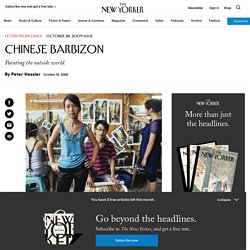
The original French Barbizon School developed during the first half of the nineteenth century, in response to the Romantic movement, among painters working at the edge of the Fontainebleau Forest. Back then, the French artists celebrated rural scenes and peasant subjects. This wasn’t exactly the mood in Lishui: like most cities in eastern China’s Zhejiang Province, the place was focussed on urban growth; there was a new factory district, and the export economy was then booming. But the local Communist Party cadres wanted the city to become even more outward-looking, and they liked the foreign cachet of the Barbizon. They also figured that it would be good business: art doesn’t require much raw material, and it’s popular overseas.
His Cat’s Death Left Him Heartbroken. So He Cloned It. BEIJING — Garlic was dead, and there was nothing Huang Yu could do.
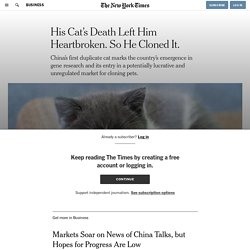
So on a cold winter day, he buried his cat’s body in a park close to his home. Hours later, still heartbroken, the 22-year-old businessman recalled an article he had read on dog cloning in China. What if someday he could bring Garlic back to life? “In my heart, Garlic is irreplaceable,” said Mr. Huang, who dug up his British shorthair and put the cat in his refrigerator in preparation for cloning him. That thought led him to Sinogene, a commercial pet-cloning company based in Beijing. It also suggests that China could turn pet cloning into a viable business. Pet cloning is not confined to China — Barbra Streisand famously declared last year that two of her dogs are clones — and people have been cloning cats for years. Mi Jidong, Sinogene’s chief executive, said the company decided to start cloning pets in 2015 after conducting a survey of roughly 1,000 people that showed there was demand.
Mr. China. “Hands up if you’re Chairman Mao”: a lookalike competition in 2008 in Hunan, Mao’s home province In China in Ten Words, the prize-winning novelist Yu Hua sets out “to compress the endless chatter of China today into ten simple words.”
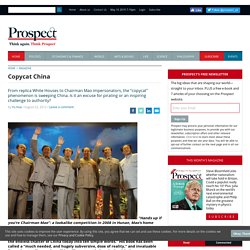
His book has been called a “much needed, and hugely subversive, dose of reality,” and invaluable for understanding modern China. Pictures of Paris Replica in China. Photographs by François Prost On the eastern coast of China—some 6,000 miles from the City of Light—a 354-foot replica of the Eiffel Tower dominates Tianducheng’s skyline.

Known as the “Paris of the East”, the luxury real estate development in Zhejiang province was designed to evoke classical European charm. Its residents have their own Arc de Triomphe, Champs Elysées main square, French neoclassical-style buildings, a fountain from the Luxembourg Gardens, and the centerpiece of the city: the second largest replica of the Eiffel Tower in the world after the Paris Las Vegas Hotel in Nevada.
When Tianducheng first opened its gates more than a decade ago, it was described as a ghost town. While many of its homes remain vacant, the population has grown into the thousands, and it attracts a steady stream of Chinese and international tourists, including newlyweds looking for a picture-perfect backdrop. “Duplitecture” Alibaba’s Global Ambitions Face Counterfeit Challenge. Alibaba’s Global Ambitions Face Counterfeit Challenge. What happens when Chinese heroes are fake? "Everything they teach you to admire is fake.
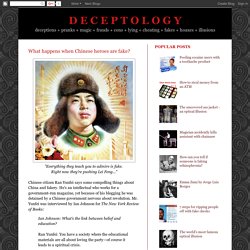
Right now they're pushing Lei Feng... " Chinese citizen Ran Yunfei says some compelling things about China and fakery. He's an intellectual who works for a government-run magazine, yet because of his blogging he was detained by a Chinese government nervous about revolution. Mr. Yunfei was interviewed by Ian Johnson for The New York Review of Books: Why Chinese companies copy.
Copycat.
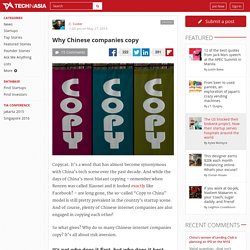
Original Copies: Architectural Mimicry in Contemporary China. A 108-meter high Eiffel Tower rises above Champs Elysées Square in Hangzhou.
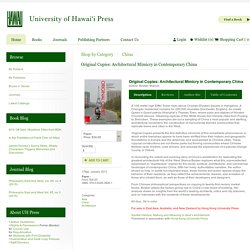
A Chengdu residential complex for 200,000 recreates Dorchester, England. An ersatz Queen’s Guard patrols Shanghai’s Thames Town, where pubs and statues of Winston Churchill abound. Gleaming replicas of the White House dot Chinese cities from Fuyang to Shenzhen. These examples are but a sampling of China’s most popular and startling architectural movement: the construction of monumental themed communities that replicate towns and cities in the West. Original Copies presents the first definitive chronicle of this remarkable phenomenon in which entire townships appear to have been airlifted from their historic and geographic foundations in Europe and the Americas, and spot-welded to Chinese cities.
From Chinese philosophical perspectives on copying to twenty-first century market forces, Bosker details the factors giving rise to China’s new breed of building. “In her fascinating new book . . . Duplitectural Marvels: Exploring China's Replica Western Cities. Why's there a Paris in Hangzhou?
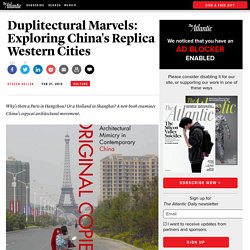
Or a Holland in Shanghai? A new book examines China's copycat architectural movement. Epcot, Universal City, and Historical Williamsburg are quaint tableaux vivant celebrating romantic fantasy, but they seem even more quaint next to China's massive replications of the world's most iconic buildings and picturesque cities.